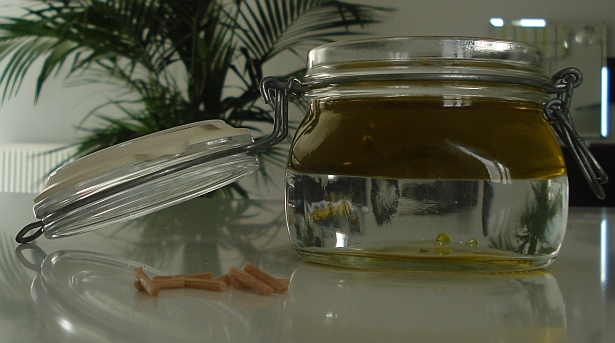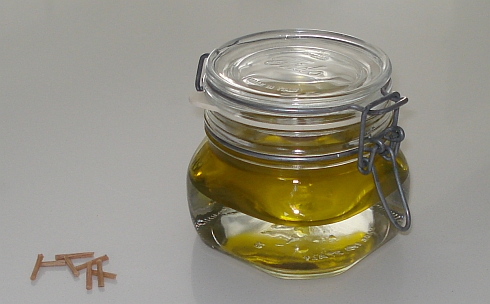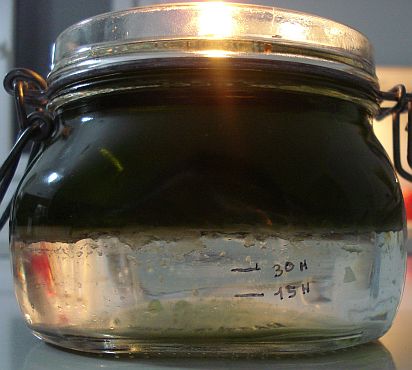
Experiments on
the olive oil fuel
by SV3ORA
An olive oil lamp
The use of oil lamps began thousands of years ago and is continued to this day, although not commonly anymore. Non-electrical lamps, based on liquid or wax fuels, can be incredibly useful when the power goes out, or for enjoying an outdoor evening barbecue. However, you may not have lamp oil on hand when you need it the most. There are many substitutes for lamp oil that have been used long enough to be deemed effective. Among them are kerosene, olive oil and canola, charcoal lighter fluid, alcohol, mineral oil, whale oil and biodiesel. The choice of the fuel to use, is limited by the availability of the fuel in your area, your everyday habits etc. Every fuel, needs a special lamp to burn in, because every fuel burns in a different way from the others. Some fuels are more flammable, whereas some others are safer and require different processes for burning.
Searching a bit around about ways to build a lamp I concluded that in my case the olive oil should be the fuel of choice. Olive oil lamps have the next advantages:
However, olive oil, like any other fuel, needs to be used in a special way in order to be extinguished. Here is my implementation of this type of lamp.

The use of this type of glass jar, has the next advantages:


Picture above, shows the jar lid closed. Picture below, shows the lamp in operation. The flame is very stable when the floating cork is at a level between the top of the open jar and the bottom of the jar's neck, which is a column about 2cm (in height) of oil.
The big cork used serves two purposes. It does not allow the wick to get upside down if the lamp gets upside down and most importantly, it serves as a stopper that does not allow the floading wick to get to the edges of the jar.
My latest addition to the lamp is shown above. A kitchen aluminum foil was wrapped on the cork, acting like a mirror, so that the light from the lamp is reflected and not get absorbed by the cork.
You may notice that the cork is not entirely circular but it has a little piece missing (top right side in the picture above). This missing piece allows water to be added to the lamp, without making the wick wet, so that the cork is lifted to the appropriate neck level for steady burning. The lamp works also without the addition of water, but as the cork gets deeper into the jar, the oxygen flow is not steady and the flame is not steady. I wanted a steady flame at all times, so I periodically add water to the lamp. However, if the lamp is going to be used outdoors on a windy day, then the flame must be allowed to be burn inside the jar, well below the jar neck, to prevent it from blown out.

A simple hours meter scale can be made by marking the level of oil after adding water into the lamp. You can choose the scale to represent the hours that the lamp is burning or the hours of remaining fuel. Just measure the level of oil after adding water to calibrate the scale. If you choose not to use the water option, then measure the level of the floating cork to calibrate the scale.
An oil lamp used as a heater
Winter is coming and the only thought one has in mind is to how to keep warm without spending a fortune. Heat costs and it costs a lot. Unfortunately, there are currently not efficient cheap machines that produce enough heat for us to get warm, so we depend on fossil fuels or electric heaters to get the large amount of instant heat we require. Both of these energy sources cost a lot. Why not using another fuel that we usually throw in the sink?
In the previous section, I have described the use of a lamp that runs out of used olive oil. I have thought of scaling up this idea to make a bigger lamp, but this time it is used not for light but for heat. The process of heating water and circulating it inside the house is well known. We usually use mineral oil or gas to do this, but if a special burner can be constructed, used olive oil could be used as well. After all, what is required to heat water by fuel, is a big flame.
For an olive oil burner, a big flame means a big wick. Commercial big wicks used for kerosene lamps are very expensive, so we have to think of alternatives. A very cheap alternative, is the common toilet paper and in fact I have found that it works very well. Picture below, shows my wick construction.

The wick is composed of a few turns of toilet paper, wound around a piece of an aluminum tube of small diameter. I use aluminium tubes because they do not oxidize inside the oil fuel. The whole structure is slipped inside another bigger diameter piece of aluminium tube. Then the whole structure is placed in a clay pot, filled with used olive oil, up to the height of the tubes. You may need to cut a bit the excess toilet paper, but do not cut it too much. When you fire the toilet paper it burns out up to the point where it meets the oil and then capillary action starts to keep the homemade wick running!
I was impressed of how easily and cheaply a
working larger wick could be made. However the drawback is that there is quite a
lot of black smoke produced by this crude setup, especially if it burns outside
on a windy day. I would say that this is not suitable for burning inside a house
without a means to take the fumes outside the house. It is more suitable as a
central heating element, like the petrol burners do.